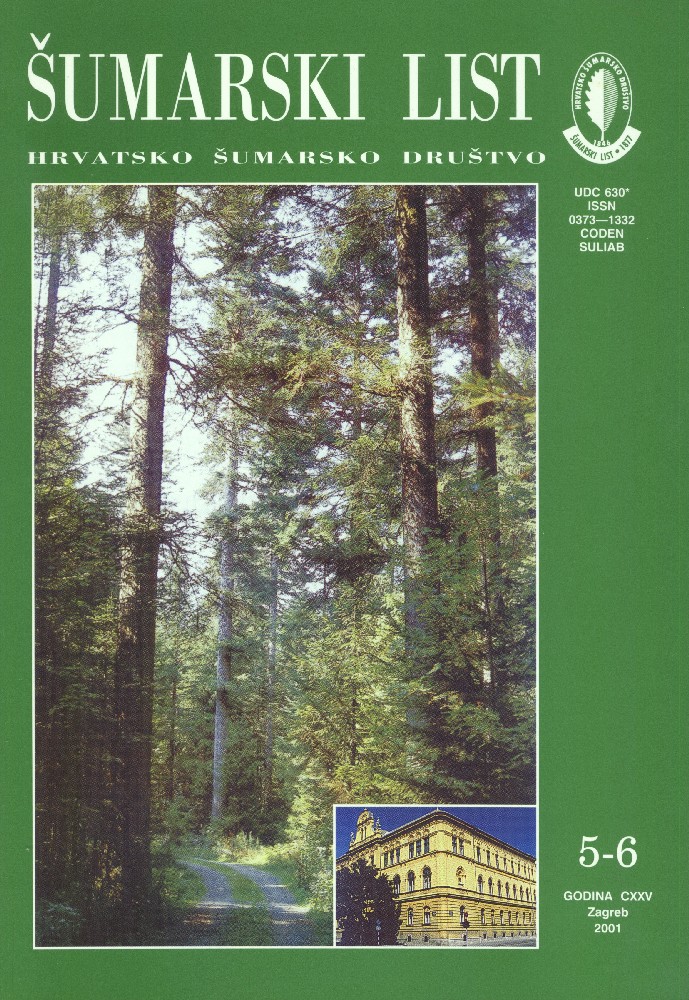
broj: 5-6/2001
pdf (28,9 MB) |
|
||||||||||||||
| IZVORNI ZNANSTVENI ČLANCI | ||
| Šmelkova, Lj. | UDK 630* 232.3 (001) | |
| Coating of Seeds of Forest Woody Species and its Impact on the Germination and Growth of Seedlings pdf HR EN | 243 | |
| Ballian, D. | UDK 630* 232.1 (Picea sitchensis (Bong.) Carr.) 001 | |
| Success in the Growth of Sitka Spruce (Picea sitchensis (Bong.) Carr.) in IUFRO Experiment in the Region of Kakanj pdf HR EN | 249 | |
| PRETHODNO PRIOPĆENJE | ||
| Zelić, J., Međugorac, K. | UDK 630* 517 + 518 | |
| The depedence of Stockwood Density of Some Autochthonous Trees on the Period of Natural Drying pdf HR EN | 263 | |
| PREGLEDNI ČLANCI | ||
| Sabadi, R. | UDK 630* 904 | |
| A Survey of French Sawmilling Industries pdf HR EN | 273 | |
| Domac, J. | UDK 630* 262+ 238 . | |
| ARBRE Project: Sustainable Energy Business and Forestry can go Together pdf HR EN | 283 | |
| Summary: Internationally adopted need to control and reduce greenhouse gas emissions has brought new life into biomass, the world´s oldest energy source used by man. Biomass utilisation in energy recovery, except for the cases of the felling of forests not scheduled for reforestation, does not contribute to an increase in greenhouse gas emissions and could be considered CO2 neutral. Biomass is an important energy source for developing countries, and its share in energy production in developed countries is recently constantly increasing, somewhere even accounting for a considerable portion of total primary energy consumption.ARBRE’s plant at Eggborough is a demonstration of biomass gasification technology, the first of its type in Europe. In the future, plants of this type can make a significant contribution to the United Kingdom’s energy supply and help in meeting commitments to the reduction of greenhouse gases. Growing concerns over the impact of mans’ activities on the global climate are driving the development of renewable energy sources. Under the Kyoto Climate Change Protocol, recently signed in New York, the European Union is committed to reducing emissions of a basket of Greenhouse Gases (most importantly carbon dioxide) to 8 % below 1990 levels by 2008 – 2012. The UK Government´s own target, irrespective of EU commitments, is for a reduction in carbon dioxide emissions to 20 % below 1990 levels by 2010. Energy generation using fossil fuels is a major source of greenhouse gases and of other pollutants. Renewable energy sources provide a cleaner alternative. The ARBRE plant will generate 10 MW of electricity from wood chips provided from forest and coppice sources. State of the art technology will be used to generate electricity – the wood is converted into a gas which fuels a high efficiency combined cycle generating process. Wood fuels are clean, renewable and can be produced in a sustainable manner. They are carbon dioxide neutral, because the carbon dioxide released when the fuel is used is equal to the carbon dioxide taken up during growth. As wood is a natural material free from harmful chemicals, its use as a fuel in this way poses no threat to the environment. The fuel sources are: • Short Rotation Coppice – Short rotation coppice consists primarily of densely planted willow shrubs harvested on a three year cycle. The root stock is left in the ground and after each harvest new shoots emerge, as in a traditional coppice • Forestry Sources – materials derived from forest and woodland management. The United Kingdom currently has the lowest proportion of energy production from renewable sources of any European Union member state. Overall the European Union plans to double the use of renewable energy sources from 6 % to 12 % by 2010. In the short term the United Kingdom has a target of 1500 MW (approximately 2 % of current capacity) of renewable electricity by the year 2000, but more will need to be done to reach the European Union’s renewable energy target and the UK´s own carbon dioxide target. Studies carried out by the Department of Trade and Industry have shown that biomass can make a substantial contribution to both the United Kingdom’s and the European Union´s energy needs. ARBRE is a significant step in this direction. Energy crops offer an exciting new commercial opportunity for farmers and growers. Short rotation coppice production allows diversification of land usage and offers substantial environmental benefits compared to intensive arable farming. These include reduced use of agrochemicals and greater ecological and landscape diversity. ARBRE is bringing the benefits that can be gained from the sustainable use of wood fuels one step closer. Key words: biomass; greenhouse gases; power plant; short rotation crops | ||
| STRUČNI ČLANCI | ||
| Kaučić, D. | UDK 630* 114+111 | |
| Anomalies Soil Temperatures in Croatia from March to August 2000. pdf HR EN | 291 | |


